Construction of Knowledge Graph for Flag State Control (FSC) Inspection for Ships: A Case Study from China
Abstract
1. Introduction
2. Literature Review
3. Methodology
3.1. Research Framework
3.2. Data Acquisition
3.3. Construction of the Ontology Model
3.4. Construction of the Data Layer
3.4.1. Knowledge Extraction
3.4.2. Knowledge Storage
4. Case Study
4.1. Data Acquisition
4.2. The Ontology Construction
4.2.1. Knowledge Concepts and Attributes
4.2.2. The Relations between Concepts
4.3. The Knowledge Extraction Experiment
4.3.1. Experimental Set-Up
4.3.2. Sequence Labeling Result
4.3.3. Entity Extraction and Validation
4.4. Knowledge Storage and Visualization
5. Discussion
6. Conclusions
Author Contributions
Funding
Institutional Review Board Statement
Informed Consent Statement
Data Availability Statement
Acknowledgments
Conflicts of Interest
References
- Ojala, J. Maritime trade and merchant shipping: The shipping/trade-ratio from the 1870s until today. SSRN Electron. J. 2016, 29, 838–854. [Google Scholar] [CrossRef]
- Zhang, G.; Thai, V.V. Expert elicitation and Bayesian Network modeling for shipping accidents: A literature review. Saf. Sci. 2016, 87, 53–62. [Google Scholar] [CrossRef]
- Chen, Q.; Lau, Y.Y.; Ge, Y.E.; Dulebenets, M.A.; Kawasaki, T.; Ng, A.K.Y. Interactions between Arctic passenger ship activities and emissions. Transp. Res. Part D Transp. Environ. 2021, 97, 102925. [Google Scholar] [CrossRef]
- Yu, Y.; Chen, L.M.; Shu, Y.Q.; Zhu, W.Y. Evaluation model and management strategy for reducing pollution caused by ship collision in coastal waters. Ocean Coast. Manag. 2021, 203, 105446. [Google Scholar] [CrossRef]
- Shu, Y.Q.; Wang, X.Y.; Huang, Z.Q.; Song, L.; Fei, Z.Q.; Gan, L.X.; Xu, Y.M.; Yin, J.C. Estimating spatiotemporal distribution of wastewater generated by ships in coastal areas. Ocean Coast. Manag. 2022, 222, 106133. [Google Scholar] [CrossRef]
- Chen, J.H.; Di, Z.J.; Shi, J.; Shu, Y.Q.; Wan, Z.; Song, L.; Zhang, W.P. Marine oil spill pollution causes and governance: A case study of Sanchi tanker collision and explosion. J. Clean. Prod. 2020, 273, 122978. [Google Scholar] [CrossRef]
- He, J.; Hao, Y.; Wang, X.Q. An Interpretable Aid Decision-Making Model for Flag State Control Ship Detention Based on SMOTE and XGBoost. J. Mar. Sci. Eng. 2021, 9, 156. [Google Scholar] [CrossRef]
- Abu-Salih, B. Domain-specific knowledge graphs: A survey. J. Netw. Comput. Appl. 2021, 185, 103076. [Google Scholar] [CrossRef]
- Tan, Z.; Zhao, X.; Wang, W.; Assoc Comp, M. Representation Learning of Large-Scale Knowledge Graphs via Entity Feature Combinations. In Proceedings of the ACM Conference on Information and Knowledge Management (CIKM), Singapore, 6–10 November 2017; pp. 1777–1786. [Google Scholar]
- Nickel, M.; Murphy, K.; Tresp, V.; Gabrilovich, E. A Review of Relational Machine Learning for Knowledge Graphs. Proc. Ieee 2016, 104, 11–33. [Google Scholar] [CrossRef]
- Heij, C.; Bijwaard, G.E.; Knapp, S. Ship inspection strategies: Effects on maritime safety and environmental protection. Transp. Res. Part D Transp. Environ. 2011, 16, 42–48. [Google Scholar] [CrossRef]
- Bolat, F.; Alpaslan, S. Cumulative Analysis of Port State Control Based on Paris MoU Inspections. Trans. Marit. Sci. 2021, 10, 224–246. [Google Scholar] [CrossRef]
- Tsou, M.C. Big data analysis of port state control ship detention database. J. Mar. Eng. Technol. 2019, 18, 113–121. [Google Scholar] [CrossRef]
- Fu, J.J.; Chen, X.Q.; Wu, S.B.; Shi, C.J.; Zhao, J.S.; Xian, J.F. Ship Detention Situation Prediction via Optimized Analytic Hierarchy Process and Naive Bayes Model. Math. Probl. Eng. 2020, 2020, 8147310. [Google Scholar] [CrossRef]
- Wu, S.B.; Chen, X.Q.; Shi, C.J.; Fu, J.J.; Yan, Y.; Wang, S.Z. Ship detention prediction via feature selection scheme and support vector machine (SVM). Marit. Policy Manag. 2022, 49, 140–153. [Google Scholar] [CrossRef]
- Liu, J.T.; Schmid, F.; Li, K.P.; Zheng, W. A knowledge graph-based approach for exploring railway operational accidents. Reliab. Eng. Syst. Saf. 2021, 207, 107352. [Google Scholar] [CrossRef]
- Tan, J.Y.; Qiu, Q.Q.; Guo, W.W.; Li, T.S. Research on the Construction of a Knowledge Graph and Knowledge Reasoning Model in the Field of Urban Traffic. Sustainability 2021, 13, 3191. [Google Scholar] [CrossRef]
- Chen, T.; Zhang, Y.; Qian, X.; Li, J. A knowledge graph-based method for epidemic contact tracing in public transportation. Transp. Res. Part C Emerg. Technol. 2022, 137, 103587. [Google Scholar] [CrossRef]
- Zhang, Q.; Wen, Y.Q.; Zhou, C.H.; Long, H.; Han, D.; Zhang, F.; Xiao, C.S. Construction of Knowledge Graphs for Maritime Dangerous Goods. Sustainability 2019, 11, 2849. [Google Scholar] [CrossRef]
- Liu, S.K.; Wang, F.X. Knowledge Graph of Maritime Collision Avoidance Rules in Chinese. In Proceedings of the 11th International Conference on Intelligent Human-Machine Systems and Cybernetics (IHMSC), Hangzhou, China, 24–25 August 2019; pp. 169–172. [Google Scholar]
- Dong, J.; Jing, X.; Lu, X.; Liu, J.; Li, H.; Cao, X.; Du, C.; Li, J.; Li, L. Process knowledge graph modeling techniques and application methods for ship heterogeneous models. Sci. Rep. 2022, 12, 2911. [Google Scholar] [CrossRef]
- Zhou, X.G.; Gong, R.B.; Shi, F.G.; Wang, Z.F. PetroKG: Construction and Application of Knowledge Graph in Upstream Area of PetroChina. J. Comput. Sci. Technol. 2020, 35, 368–378. [Google Scholar] [CrossRef]
- Ji, S.X.; Pan, S.R.; Cambria, E.; Marttinen, P.; Yu, P.S. A Survey on Knowledge Graphs: Representation, Acquisition, and Applications. IEEE Trans. Neural Netw. Learn. Syst. 2022, 33, 494–514. [Google Scholar] [CrossRef] [PubMed]
- Liu, P.C.; Huang, Y.L.; Wang, P.; Zhao, Q.F.; Nie, J.; Tang, Y.Y.; Sun, L.; Wang, H.L.; Wu, X.L.; Li, W.B. Construction of typhoon disaster knowledge graph based on graph database Neo4j. In Proceedings of the 32nd Chinese Control And Decision Conference (CCDC), Hefei, China, 22–24 August 2020; pp. 3612–3616. [Google Scholar]
- Rubin, D.L.; Noy, N.F.; Musen, M.A. Protege: A tool for managing and using terminology in radiology applications. J. Digit. Imaging 2007, 20, 34–46. [Google Scholar] [CrossRef] [PubMed]
- Kamel, M.N.; Lee, A.Y.; Powers, E.C. A methodology for developing ontologies using the Ontology Web Language (OWL). In Proceedings of the 9th International Conference on Enterprise Information Systems (ICEIS 2007), Funchal, Portugal, 12–16 June 2007; pp. 261–268. [Google Scholar]
- Tenney, I.; Das, D.; Pavlick, E. BERT Rediscovers the Classical NLP Pipeline. In Proceedings of the 57th Annual Meeting of the Association-for-Computational-Linguistics (ACL), Florence, Italy, 28 July–2 August 2019; pp. 4593–4601. [Google Scholar]
- Cho, K.; Merrienboer, B.V.; Gulcehre, C.; Ba Hdanau, D.; Bougares, F.; Schwenk, H.; Bengio, Y. Learning Phrase Representations using RNN Encoder-Decoder for Statistical Machine Translation. arXiv 2014. [Google Scholar] [CrossRef]
- Qin, Q.L.; Zhao, S.; Liu, C.M. A BERT-BiGRU-CRF Model for Entity Recognition of Chinese Electronic Medical Records. Complexity 2021, 2021, 6631837. [Google Scholar] [CrossRef]
- Sutton, C.; McCallum, A.; Rohanimanesh, K. Dynamic conditional random fields: Factorized probabilistic models for labeling and segmenting sequence data. J. Mach. Learn. Res. 2007, 8, 693–723. [Google Scholar]
- Sherstinsky, A. Fundamentals of Recurrent Neural Network (RNN) and Long Short-Term Memory (LSTM) network. Phys. D Nonlinear Phenom. 2020, 404, 132306. [Google Scholar] [CrossRef]
- Li, F.G.; Zhang, B.K.; Gao, D. Chinese Named Entity Recognition for Hazard And Operability Analysis Text. In Proceedings of the 32nd Chinese Control And Decision Conference (CCDC), Hefei, China, 22–24 August 2020; pp. 374–378. [Google Scholar]
- Nadeau, D.; Sekine, S. A survey of named entity recognition and classification. Lingvisticae Investig. 2007, 30, 3–26. [Google Scholar] [CrossRef]
- Ganguly, D.; Roy, D.; Mitra, M.; Jones, G.J.F. A Word Embedding based Generalized Language Model for Information Retrieval. In Proceedings of the 38th Annual International ACM SIGIR Conference on Research and Development in Information Retrieval (SIGIR), Santiago, Chile, 9–13 August 2015; pp. 795–798. [Google Scholar]
- Cho, M.; Ha, J.; Park, C.; Park, S. Combinatorial feature embedding based on CNN and LSTM for biomedical named entity recognition. J. Biomed. Inform. 2020, 103, 103381. [Google Scholar] [CrossRef]
- Liu, K.Z.; Yu, Q.; Yuan, Z.T.; Yang, Z.S.; Shu, Y.Q. A systematic analysis for maritime accidents causation in Chinese coastal waters using machine learning approaches. Ocean Coast. Manag. 2021, 213, 105859. [Google Scholar] [CrossRef]
- Bye, R.J.; Holmen, I.M.; Størkersen, K.V. Safety in marine and maritime operations: Uniting systems and practice. Saf. Sci. 2021, 139, 105249. [Google Scholar] [CrossRef]
- Hamad, H.B. The Roles of Flag States in Maritime Security Governance: A Case Study of the East African Community. Soc. Sci. Electron. Publ. 2017, 6, 95–102. [Google Scholar]
- Zhang, S.; Chen, J.; Wan, Z.; Yu, M.; Shu, Y.; Tan, Z.; Liu, J. Challenges and countermeasures for international ship waste management: IMO, China, United States, and EU. Ocean Coast. Manag. 2021, 213, 105836. [Google Scholar] [CrossRef]
- Xu, S.Y.; Hu, H. Development of a maritime safety management database using relational database approach. Int. J. Shipp. Transp. Logist. 2019, 11, 334–353. [Google Scholar] [CrossRef]
- Wang, Y.H.; Zhang, F.; Yang, Z.S.; Yang, Z.L. Incorporation of deficiency data into the analysis of the dependency and interdependency among the risk factors influencing port state control inspection. Reliab. Eng. Syst. Saf. 2021, 206, 107277. [Google Scholar] [CrossRef]
- Yan, R.; Wang, S.; Cao, J.; Sun, D. Shipping Domain Knowledge Informed Prediction and Optimization in Port State Control. Transp. Res. Part B Methodol. 2021, 149, 52–78. [Google Scholar] [CrossRef]
- Osman, M.T.; Yuli, C.; Li, T.; Senin, S.F. Association rule mining for identification of port state control patterns in Malaysian ports. Marit. Policy Manag. 2021, 48, 1082–1095. [Google Scholar] [CrossRef]
- Kara, E.G.E.; Oksas, O.; Kara, G. The similarity analysis of Port State Control regimes based on the performance of flag states. Proc. Inst. Mech. Eng. Part M J. Eng. Marit. Environ. 2020, 234, 558–572. [Google Scholar] [CrossRef]
- Fan, L.X.; Luo, M.F.; Yin, J.B. Flag choice and Port State Control inspections—Empirical evidence using a simultaneous model. Transp. Policy 2014, 35, 350–357. [Google Scholar] [CrossRef]
- Demirci, S.M.E.; Cicek, K.; Ozturk, U. A Fuzzy Rule-Based Ship Risk Profile Prediction Model for Port State Control Inspections. In Proceedings of the INFUS 2021 Conference, Istanbul, Turkey, 24–26 August 2021; pp. 498–505. [Google Scholar]
- Hänninen, M.; Kujala, P. Bayesian network modeling of Port State Control inspection findings and ship accident involvement. Expert Syst. Appl. 2014, 41, 1632–1646. [Google Scholar] [CrossRef]
- Zhang, L.F.; Gang, L.H.; Liu, Z.J. Analyzing Inspection Results of Port State Control by Using PCA. Appl. Mech. Mater. 2014, 686, 730–735. [Google Scholar] [CrossRef]
- Chen, J.H.; Zhang, S.H.; Xu, L.; Wan, Z.; Fei, Y.J.; Zheng, T.X. Identification of key factors of ship detention under Port State Control. Mar. Policy 2019, 102, 21–27. [Google Scholar] [CrossRef]
- Yoon, B.-H.; Kim, S.-K.; Kim, S.-Y. Use of Graph Database for the Integration of Heterogeneous Biological Data. Genom. Inform. 2017, 15, 19–27. [Google Scholar] [CrossRef] [PubMed]
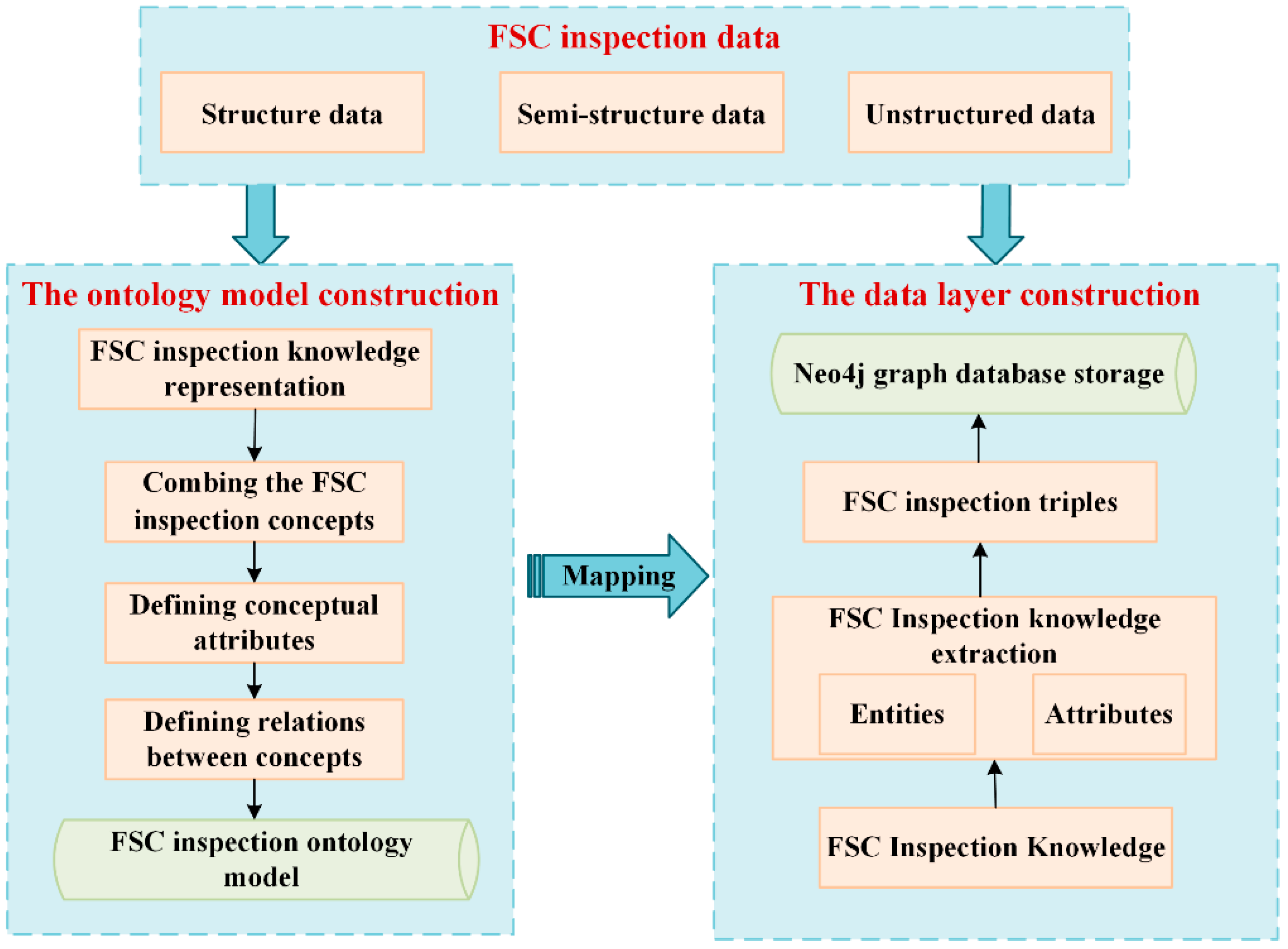
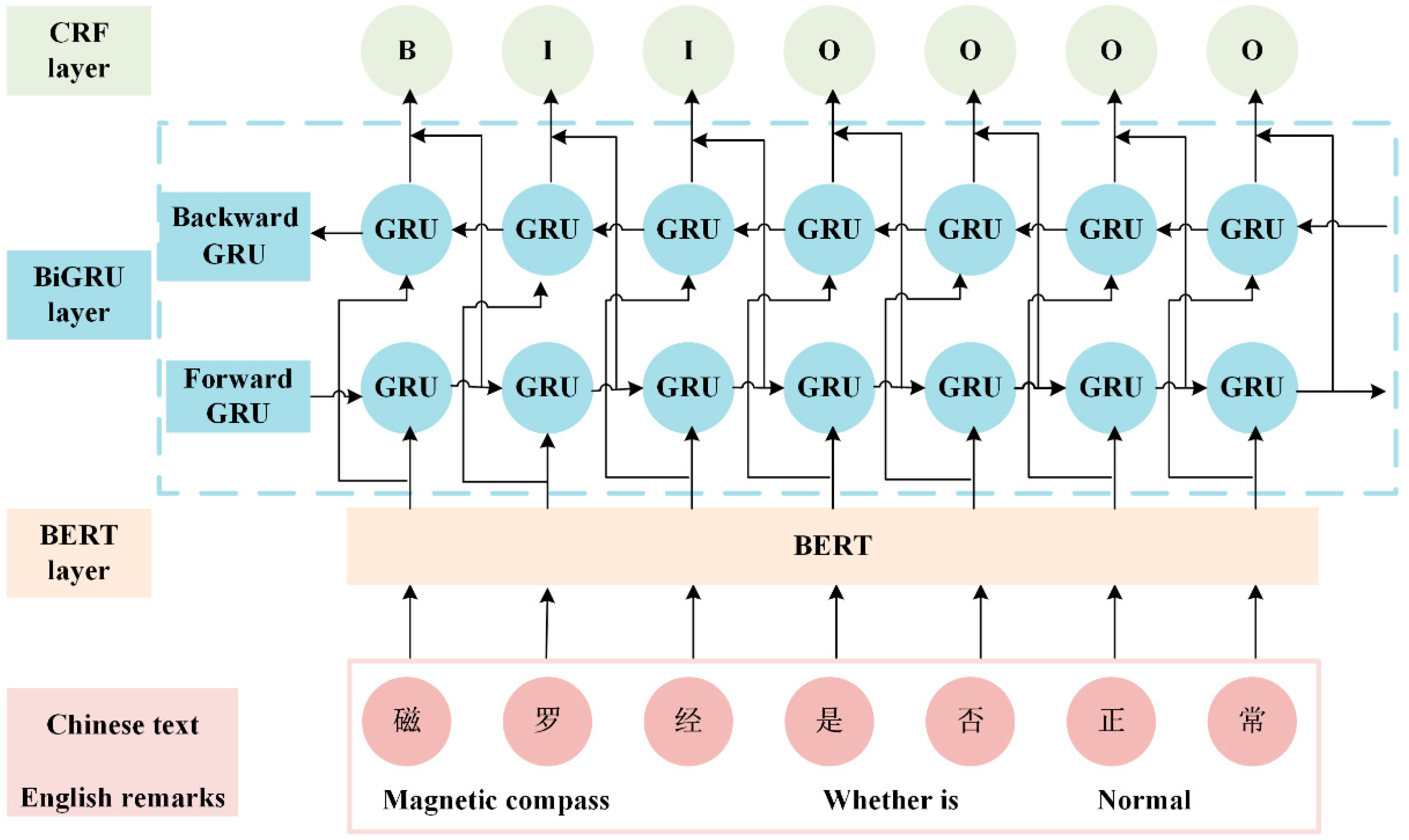

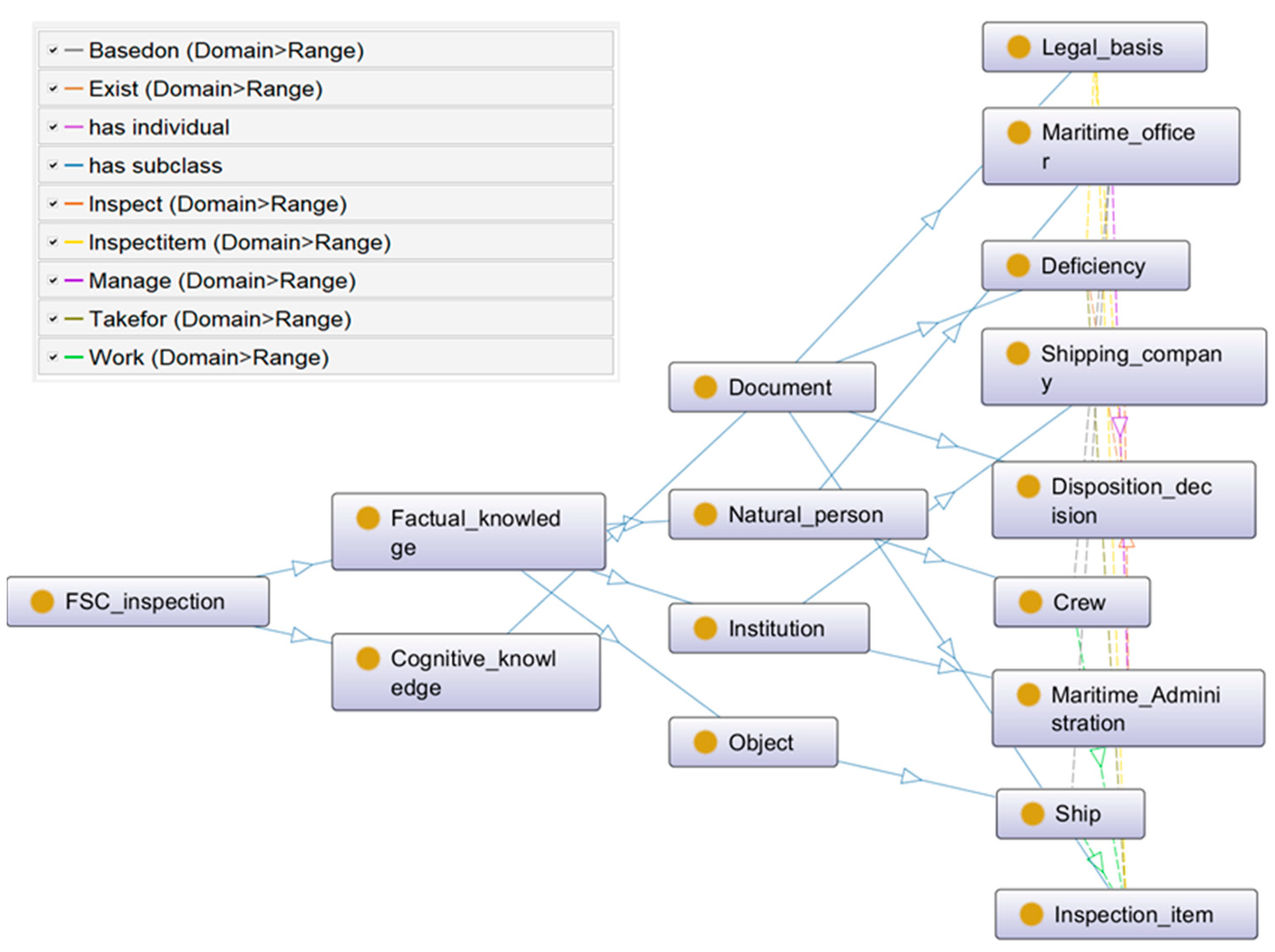





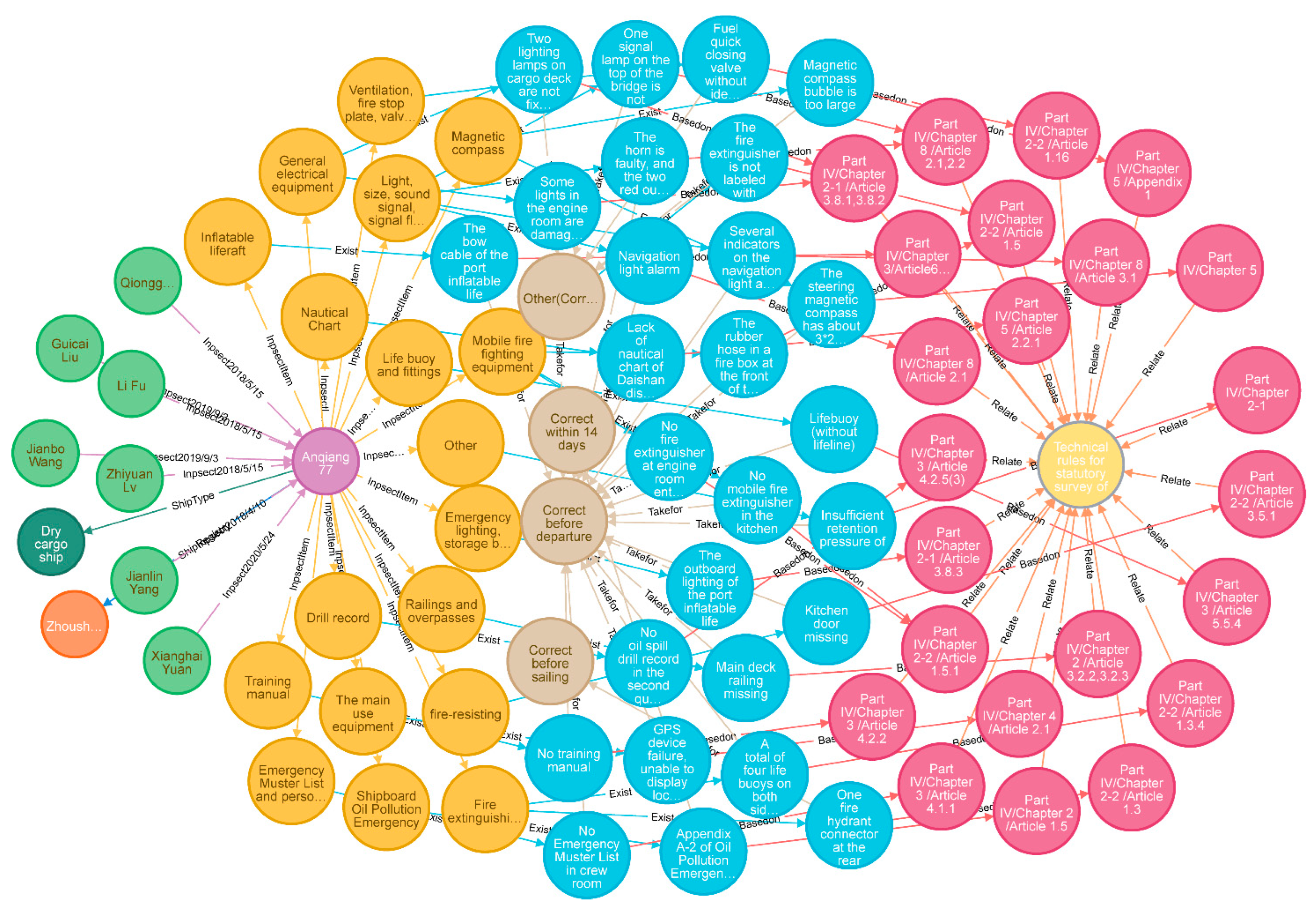
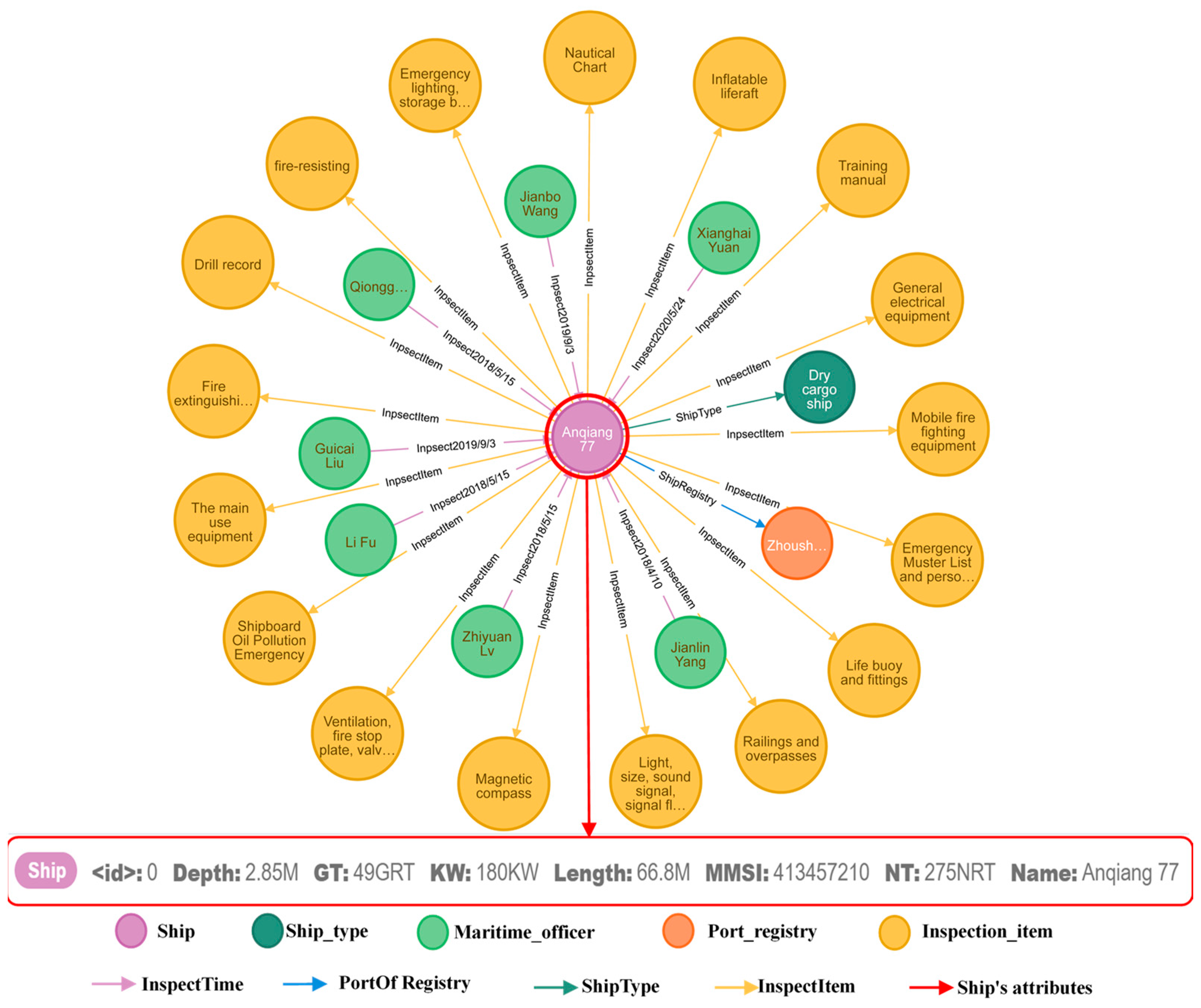
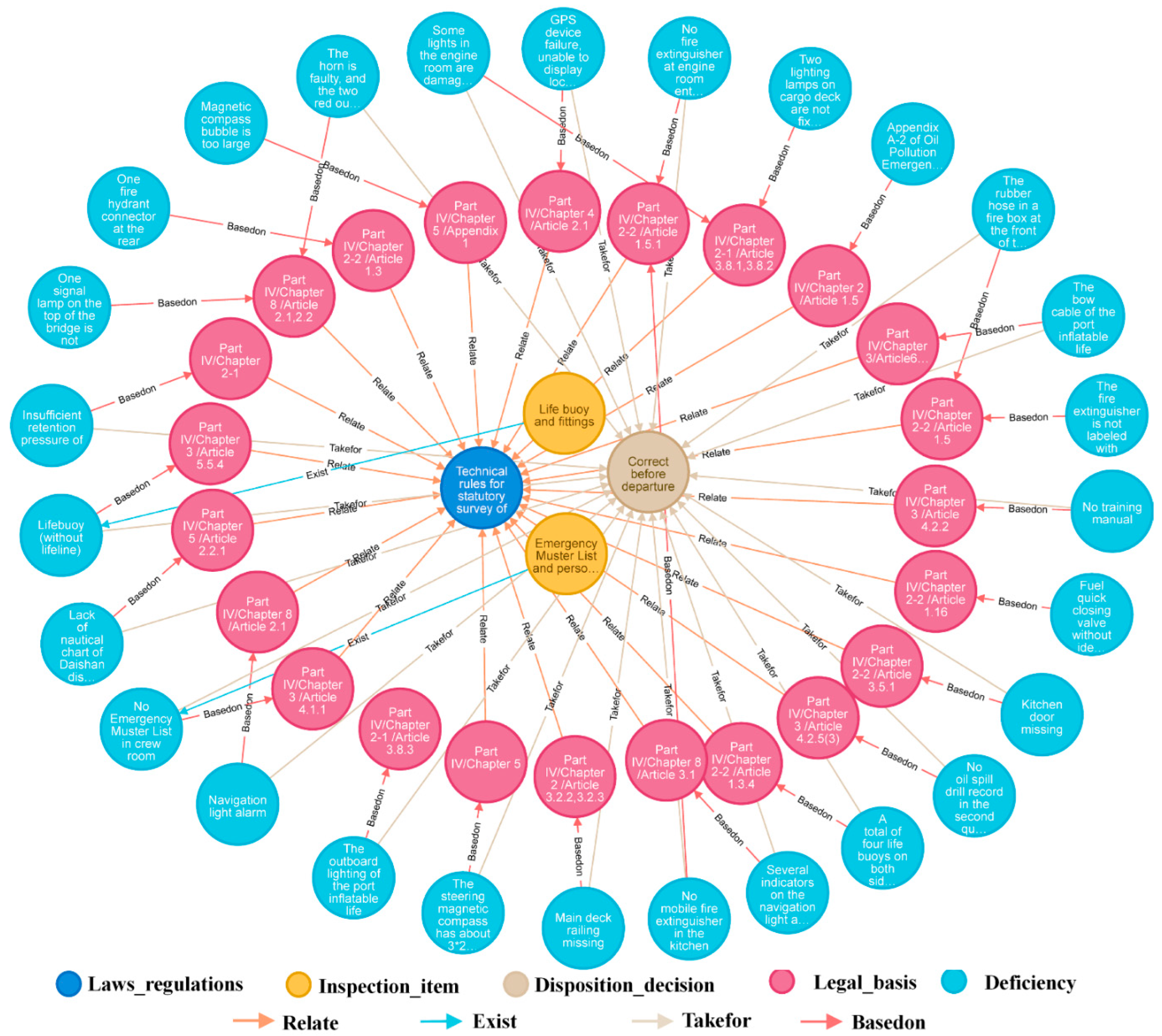
| Knowledge Category | The First-Level Concepts | The Second-Level Concepts | Attributes |
|---|---|---|---|
| Factual knowledge | Natural person | Maritime officer | Name, gender, position, work unit |
| Crew | Name, gender, position, qualification information | ||
| Object | Ship | Type, ship identification number, length, breadth, port of registry | |
| Institution | Maritime administration authority | Affiliation, Responsibilities, Jurisdiction | |
| Shipping company | Name, audit information, location | ||
| Cognitive knowledge | Documentation | Legal basis | Object-oriented, the scope of application, legal period, the content of articles |
| Disposition decision | Decision codes, the scope of application | ||
| Inspection item | Types, object orientation, bullet points | ||
| Deficiency | Deficiency code, the scope of application |
| Relation Label | Head Entity and Tail Entity | Description |
|---|---|---|
| Inspect | Maritime officer—Ship | Maritime officers inspect ships |
| Maritime officer—Crew | Maritime officers inspect the crew | |
| Manage | Maritime administration authority—Shipping company | The maritime administration authority manages the shipping company |
| Shipping company—Ship | The shipping company manages the ship | |
| Work | Maritime officer—Maritime administration authority | A maritime officer works in a maritime administration authority |
| Crew—Ship | Crew work on a ship | |
| InspectItem | Crew—Inspection item | The inspection item of the crew |
| Ship—Inspection item | The inspection item of the ship | |
| TakeFor | Deficiency—Disposition decision | Take disposition decisions for deficiencies |
| Exist | Inspection item—Deficiency | An inspection item exists deficiencies |
| BasedOn | Inspection item—Laws and regulations | The inspection item is based on laws and regulations |
| Deficiency—Laws and regulations | The deficiency is based on laws and regulations | |
| Disposition decision—Laws and regulations | The disposition decision is based on laws and regulations |
| Experimental Parameters | Meaning | Value |
|---|---|---|
| Max_seq_len | Maximum sentence length in the BERT layer | 100 |
| Batch_size | The number of samples passed to the program for training in a single iteration | 16 |
| Epoch | The number of updates when all training data has been used once | 50 |
| BiGRU_units | The hidden unit of BiGRU | 128 |
| Dropout | The parameter used to prevent overfitting | 0.5 |
| Label | Entity | The Specific Meaning |
|---|---|---|
| CEDO | Certificate documents | The ship, crew provisioning, and holding of relevant statutory certificates and related materials |
| PCT | Passenger and cargo transportation | The ship’s carrying of passengers, cargo, precautions, and cargo securing and lashing |
| CMDP | Crew staffing and duty performance | The situation of the crew on the ship, and the crew performing their duties, including the maintenance of facilities and equipment related to their duties, and the actual operation ability |
| STR | Ship structure | The internal and external structure of the ship, such as ship skeleton form, fire prevention structure and its corresponding requirements, the type of ship pipe system and layout requirements, etc. |
| FAEQ | Facility and equipment | The facilities and equipment used to complete the navigation, berthing and unberthing, loading and unloading of goods and other production operations of ships, and to ensure the safety of ships and personnel |
| REQ | Inspection requirements | The checkpoints and attention points required by FSC inspection |
| FSC Inspection Entities | P | R | F1 |
|---|---|---|---|
| Certificate documents | 100.00 | 73.33 | 84.62 |
| Passenger and cargo transportation | 83.33 | 90.91 | 86.96 |
| Crew manning and duty performance | 100.00 | 93.33 | 96.55 |
| Ship structure | 92.86 | 100.00 | 96.30 |
| Facility and equipment | 85.45 | 95.92 | 90.38 |
| Inspection requirements | 79.69 | 87.93 | 83.61 |
| P | R | F1 | |
|---|---|---|---|
| BiGRU-CRF | 70.37 | 78.24 | 74.09 |
| Word2Vec-BiGRU-CRF | 73.68 | 82.35 | 77.78 |
| BERT-CNN-LSTM | 75.13 | 85.06 | 79.78 |
| BERT-BiGRU-CRF | 86.41 | 91.38 | 88.83 |
Publisher’s Note: MDPI stays neutral with regard to jurisdictional claims in published maps and institutional affiliations. |
© 2022 by the authors. Licensee MDPI, Basel, Switzerland. This article is an open access article distributed under the terms and conditions of the Creative Commons Attribution (CC BY) license (https://creativecommons.org/licenses/by/4.0/).
Share and Cite
Gan, L.; Chen, Q.; Zhang, D.; Zhang, X.; Zhang, L.; Liu, C.; Shu, Y. Construction of Knowledge Graph for Flag State Control (FSC) Inspection for Ships: A Case Study from China. J. Mar. Sci. Eng. 2022, 10, 1352. https://doi.org/10.3390/jmse10101352
Gan L, Chen Q, Zhang D, Zhang X, Zhang L, Liu C, Shu Y. Construction of Knowledge Graph for Flag State Control (FSC) Inspection for Ships: A Case Study from China. Journal of Marine Science and Engineering. 2022; 10(10):1352. https://doi.org/10.3390/jmse10101352
Chicago/Turabian StyleGan, Langxiong, Qiaohong Chen, Dongfang Zhang, Xinyu Zhang, Lei Zhang, Chengyong Liu, and Yaqing Shu. 2022. "Construction of Knowledge Graph for Flag State Control (FSC) Inspection for Ships: A Case Study from China" Journal of Marine Science and Engineering 10, no. 10: 1352. https://doi.org/10.3390/jmse10101352
APA StyleGan, L., Chen, Q., Zhang, D., Zhang, X., Zhang, L., Liu, C., & Shu, Y. (2022). Construction of Knowledge Graph for Flag State Control (FSC) Inspection for Ships: A Case Study from China. Journal of Marine Science and Engineering, 10(10), 1352. https://doi.org/10.3390/jmse10101352







